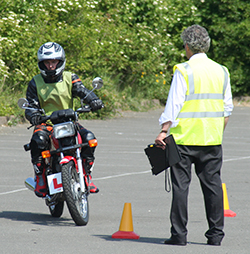 The Department of the Environment (DOE) has silently issued a document on their Road Safety website, which contains the Summary of Consultation Responses, the Department’s Response, and Next Steps regarding the implementation of the 3rd EC Directive On Driving Licences.
The Department of the Environment (DOE) has silently issued a document on their Road Safety website, which contains the Summary of Consultation Responses, the Department’s Response, and Next Steps regarding the implementation of the 3rd EC Directive On Driving Licences.
The directive from the European Union, which must be transposed into national legislation by 19th January 2011 and enter into force as of 19th January 2013, is designed to harmonize motorcycle licences across Europe and will introduce a system of progressive and direct access to a motorcycle licence through a testing regime.
In May 2010 Right To Ride replied to the madness contained in the DOE’s consultation.
At that time we stated that, “The DOE has unfortunately moved well beyond the spirit of the directive.” – “Apart from the complexity of the DOE proposal which was put out to consultation, it offers no benefit to riders.” – “We strongly disagree with the consultation proposals which aim to introduce provisional licences granted for all categories of licence entitlement. In our opinion these proposals are prescriptive and convoluted and badly thought through.” – “The irony is that these proposals will effectively undermine the EU directive on all counts and encourage riders to become “permanent learners”.
With regards to whether there should be a further test or training between certain licence categories, we recommended that, “.. the DOE investigates further the values of cost beneficial 7 hours structured, relevant and cost-effective basic training to give the rider moving between licence categories, the essential skills and knowledge capable of safely operating a motorcycle continuously in normal traffic situations on public roads.”
So what has the DOE published?
Well there were eighteen responses to the consultation, from one large company to five Representative Organisations, two Interest Groups, four from Local Government, three from Central Government, one member of the public and two others. Five of these simply noted/acknowledged the proposals but did not express any views on them.
Synopsis of responses to the consultation on the Third EC Directive on Driving Licences
Regarding testing or training between certain licence categories, the Department intends to proceed with the testing option, however the training option will be kept under review with regard to its financial viability.
However, the Department will revisit the training option. Any training option will be developed with motorcycle stakeholders to ensure it meets the needs of learner motorcyclists whilst remaining within scope of the Directive.
The content of the motorcycle test is specified in the Directive and as such the format of the tests for each category will be the same. However as the rider progresses to the next category of licence they will no longer be restricted to 45 miles per hour which will allow them to be tested at higher speeds on test routes which will be more demanding. In addition the bigger motorcycles will have differing weights and handling characteristics which will ensure that the tests are suitably challenging.
Having taken into account the strong views of the respondents the Department has decided that the proposal for a compulsory familiarisation course to validate provisional A2 and A licences under the progressive access route will not now be implemented.
Instead all riders wishing to ride category A2 or A motorcycles who have not yet qualified for a full licence for the larger category will have to be accompanied by an Approved Motorcycle Instructor (AMI) when riding on the roads – whether in direct access or progressive access routes.
The current provisional licence arrangements for mopeds and category A1 motorcycles which allow riders who have passed CBT to ride unaccompanied on these smaller machines will remain unchanged.
The new arrangements for provisional motorcycle entitlement will be similar to those already in place. Currently, a person applying for a moped licence at age 16 will be granted a licence which includes provisional categories A and B.
However, these entitlements will only become active when the licence holder reaches the relevant minimum age (i.e. 17).
Similarly, a person applying for category A1 at age 17 (after implementation of the 3rd Directive) will also be granted provisional category A2 (which becomes active at age 19) and provisional category A (which becomes active at age 24, unless category A2 is passed, at which time progressive access arrangements apply).
The licence holder will not be required to apply for each provisional motorcycle entitlement separately.
The Department is now proceeding with the drafting of the necessary legislation.
A project team has been set up to oversee the implementation of the 3rd Directive. The project will include an implementation plan which will include a communication plan. This communication plan will ensure that the changes will be fully explained to keep stakeholders and interested parties informed of the changes being made.
Staff at DVA (Driver and Vehicle Agency) are working closely with their counterparts (DSA – Driving Standards Agency & DVLA – Driver and Vehicle Licensing Agency) in GB to ensure, where possible, that there is a consistent approach throughout the UK. To this end DVA are represented on a number of GB working groups and are a member of their project board, and in turn DSA are represented on the NI project board.
Right To Ride – Conclusion
Basically the consultation regarding motorcycles has moved from a starting point at point A and returned to the same point.
The only real conclusion is that there will be testing between certain licence categories and not training, although this will be kept under review, with some of the unworkable suggestions that came from the DfT (Department for Transport) in GB being shelved.
As an exercise in consultation, the DOE has met its obligation, however the poor response (18 in total) suggests that the DOE is not very good at publicizing consultations. In this case the inadequate response has not really given them the opportunity of drawing from a wider range of views.
The best case scenario would be that there was no 3rd Driving Licence Directive to be implemented at all, however what we have ended up with at present for riders is not that bad!
We can only hope that the project team that has been set up to oversee the implementation of the 3rd Directive, which includes an implementation plan which in turn will include a communication plan, to ensure that the changes will be fully explained to keep stakeholders and interested parties informed!


Speak Your Mind